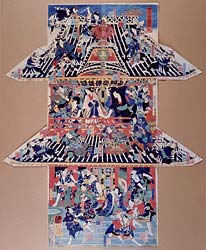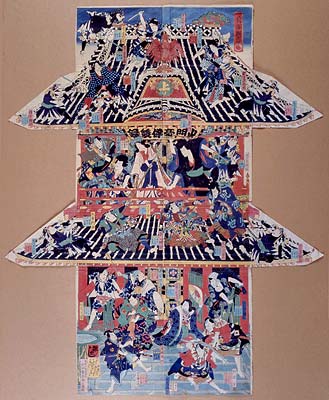Sugoroku gradually began to decline after the seventeenth century, as competition from other games increased and arts and entertainments diversified. In gambling, dice games were dominant, and cards (karuta, from the Portuguese carta) also emerged. In addition, tomikuji (lottery) and mikasazuke (haiku-based lottery) entered the world of games. Gambling with dice became more popular than sugoroku, perhaps because the results were immediate, reflecting the quickened pace of life in the eighteenth and nineteenth centuries. E-sugoroku, thanks to interesting themes and innovative pictorialization, came to overshadow sugoroku, while board games of strategy (such as go and shogi) became popular.

|
Games of Chance | ||||||||||||

Toyohara Kunichika (1835–1900?)
|
Sugoroku: Japan's Backgammon
In Japan, a game similar to trictrac (or trick-track) and backgammon
is ban-sugoroku (board sugoroku), as distinct
from e-sugoroku (picture sugoroku). Sugoroku,
in Japanese, literally means “two sixes.” This must
be derived from the characters used in the name for Chinese versions
of the game shuang lu, which has the same meaning. “Two
(or double) sixes” signifies twelve boxes, or spaces, referring
to the two rows of twelve spaces each on the board. Japanese sugoroku
follows the same rules as backgammon; the initial configuration
of pieces, or stones, is also identical. The main differences in
the design of the board are found in its proportions and the playing
surface. The Japanese sugoroku board resembles a box, with
its top face divided into three parallel sections. Two outer sections,
each divided into twelve rectangular spaces, flank the center section,
where stones taken from the opponent are placed. In contrast, the
conventional, modern backgammon board is characterized by elongated
triangular spaces. Sugoroku is the oldest known board game
in Japan. It enjoyed great popularity from the twelfth to the sixteenth
century.
|
||||||||||||




